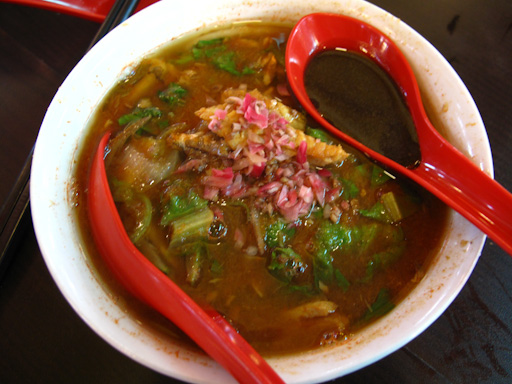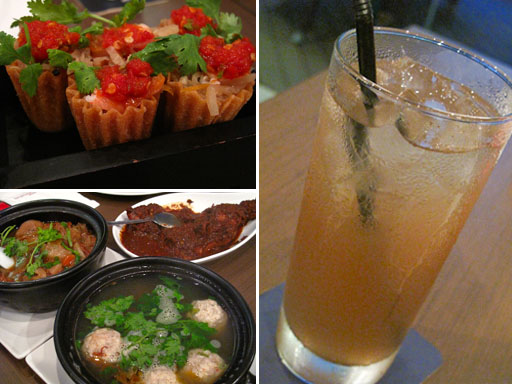Ah, Malaysia and Singapore… otherwise known as foodie heaven. The mix of cultures there makes for an incredible variety of dining options, and everyone who lives there not only loves to eat but knows their food.
When I visited in August, I had food I’d never eaten before as well as food I grew up with on the streets of Toronto. In fact, one of our favorite family outings was going to the dai pai dong food court (similar to the Singaporean hawker centers) in the basement of Dragon City in Toronto’s Chinatown and ordering what we called “chow gweh,” or char koay kak in Malaysia. After we moved to the desertlands of Phoenix, Arizona, my parents would trek all the way to one particular restaurant in LA just to eat chow gweh, among other things.
Making poh piah (spring roll) wrappers in Penang.
Armed with my notes compiled from various sites and several free and detailed eating guides at the Penang airport (that’s how seriously they take their food!), I set out to eat my way through these two countries.
I usually tell people I eat way more than they probably think I do, but when I travel and try to pack as many meals into a day as possible, I soon realize I can only devour so much. There was a lot I didn’t get a chance to try (one of the drawbacks of traveling on your own… I’ll just have to go back!). On my last day in Singapore, I attempted to order fish head curry, since it is one of the quintessential Singaporean dishes that I still hadn’t tried. Only I was met with a confused look and a series of questions: “You want it to go?” (No.) “You’re ordering it all by yourself?” (Yes…) “Really?” And then I finally realized that it is an enormous and slightly expensive dish that you normally share. So I ended up getting chicken rice instead. :P
No matter, I still managed to have plenty of great food during my stay! Here are some highlights…
Char koay teow. This stir-fried rice noodle dish was the first thing I ordered after setting foot in Penang. It reminded me a bit of Cantonese beef chow fun, only with the exceptional improvement of cockles and fried lard croutons in lieu of beef. It was also my first time having nutmeg juice, made from the fresh fruit!
Breakfast at Toh Soon Cafe in Penang. Two new friends brought me here for a traditional Malaysian breakfast of kaya (coconut jam) toast, soft-boiled eggs with pepper and soy sauce, nasi lemak (coconut rice with anchovies, hard-boiled egg, and chili), and coffee. What a great way to start the day!
Assam laksa. One of the dishes I needed to try in Penang was assam laksa, a Penang take on the Peranakan rice noodle soup. Assam laksa is named for the tamarind that flavors the broth, and it is also characterized by the use of fish. To me this tasted like a marriage of Vietnamese canh chua, which is a tamarind fish soup, and bun bo hue, which has similar rice noodles and plenty of lemongrass, all topped off with some shrimp paste.
Ramadan food bazaars. I happened to be in Malaysia and Singapore during the month of Ramadan, and between the two countries, I visited plenty of evening Ramadan bazaars. They are so lively and sometimes a bit crazy! The bazaars had Arabic, Malay, Indian, Chinese, and various blendings of those foods. I got so overwhelmed. It was almost enough just to walk through the aisles. Almost. :)
Indian food. I also had the chance to sample various Indian dishes, which I was told by a friend tended to represent more southern Indian food, whereas what we usually eat in the US tends to be northern Indian. I absolutely love roti canai and ate it whenever I could. It’s a traditional Indian flatbread that’s beautifully flaky from plenty of fat and delicious dipped in curry. I also had teh tarek (pulled tea) for the first time — tea and condensed milk “pulled” by pouring back and forth from up high in order to create a nice layer of froth at the top. A friend also took me to a vegetarian place called Annalakshmi at the Temple of Fine Arts in Penang, where you pay as you like, and the money goes toward a clinic that the organization runs. One of my favorite things about Malaysia and Singapore is how various cultures are living side by side and mixing or adopting customs from each other. At Annalakshmi, we got an order of char koay teow (which has Chinese roots) alongside our dosa masala and mango lassi. I also received durian advice from the Indian Malaysians sitting next to us, whose English I noticed happened to be littered with the Chinese “la”!
Chicken rice. Originally known as Hainanese chicken and rice, this is a popular southern Chinese meal that somehow ended up becoming Singapore’s national dish. It’s a variation on one of my old favorites — poached chicken — and it’s something I could eat every day and practically do when I’m in Hong Kong and, most recently, Beijing (in fact, I started feeling guilty for the frequency with which I ordered poached chicken in Beijing when there were so many other foods to be tried). What makes Hainanese chicken and rice different is that the rice is cooked with the chicken juices and broth, giving it lots of flavor. In Singapore, the chicken is eaten with a dipping sauce made of chili, garlic, and ginger.
Peranakan food. Peranakans — or Straits Chinese or Baba Nyonya — are descendants of 16th-century Chinese immigrants who married local Malays. It was really my first encounter with this culture, and I was surprised to learn that both of the friends I visited in Singapore were of part Peranakan descent. I was so fascinated I made a special trip to the Peranakan Museum (in Singapore) the very next day to learn more about the history and culture. My friend Greg is half Peranakan, and he took me to one of his favorite restaurants called Spice Peranakan, which quite amusingly happens to be located in a government research complex, so we had to walk through hallways filled with biohazardous warning signs before getting to dinner. :)
I was grateful I had Greg to order and explain the dishes to me here. I learned that Peranakan food in Penang (like assam laksa) has some Thai influences and can be a bit more sour in taste. By contrast, Peranakan food in Malacca or Singapore has more Indonesian influence. Not being that familiar with Indonesian cuisine, I found myself reminded instead of Native American food, where long, slow cooking has reduced sauces down to very thick, rich, fragrant-sweet flavors. Pictured here are (1) kueh pie tee in the top left – crispy cups filled with turnip and topped with chili and cilantro; (2) lemongrass and pandan leaf drink on the right; and (3) in the last photo on the bottom left, clockwise from the soupy meatball dish in the foreground: bakwah kepeting – flower crabmeat, minced pork, prawns, and bamboo shoots rolled into meatballs and boiled in chicken stock; chap chye – mixed vegetables drowned in tau chio or fermented beans; and lastly the star dish, ayam buah keluak – Indonesian black nuts stuffed with minced pork and prawns and cooked in a rich, sour gravy. Greg told me that the black nuts alone have to be soaked a couple days to lose their bitter taste, and ayam buah keluak is one of those dishes that few places make well anymore.
Durian. I’ll take any excuse to explore more of Southeast Asia, but this particular trip really all started with my fascination with durian… I’ve always wanted to write about it, and I thought if I could just get to Penang, the details would sort themselves out later. This was only my second time traveling in a foreign country by myself without knowing anyone (my first being in Vietnam), and I have to say, getting into Kuala Lumpur at 10pm, navigating the transportation system, and realizing (around midnight) that I was going to have to make the last leg of the trip to the hotel via cab (which I’d read somewhere to avoid…) was pretty stressful! Normally I am more cautious about not traveling after dark, but I made an exception for a budget fare this time. And, in some ways, I did it all for durian. Hopefully, you’ll be hearing more from me on this pungent, pungent fruit, the aphrodisiac of Southeast Asia.
Resources. I couldn’t have done without these resources in preparation for this fooding adventure…
Cradle of Flavor by James Oseland – Amazing book on the foods of Indonesia, Singapore, and Malaysia by the editor-in-chief of Saveur magazine. I was surprised to learn that his love for food and cooking actually started when he visited Indonesia as a teenager. I daydreamed away through the early chapters on Oseland’s travels and encounters with the flavors and foods there. And I’ve recently started trying out some of the recipes with a few of the ingredients I brought home with me. What I love about this book is that it’s not only full of love for the foods and cultures of the Spice Islands, but it’s also completely practical, with thorough descriptions of unfamiliar ingredients, techniques, and how to find and store those ingredients or substitutes in the US. I so wanted to visit Indonesia this time as well, but I just didn’t have the guts to venture there on my own. It’s definitely at the top of my travel list!
Eating Asia – How much do I love this blog? The photos, the writing, the articles, the research… I scoured the archives for not only KL and Penang, but also Chengdu and other parts of China. Eckhardt’s article on George Town and this one on KL are great too.
An Insider’s Guide to Penang Hawker Food by Rasa Malaysia – You can be sure I’ll be stalking this blog for recipes the next few months!
Chubby Hubby’s Ten Singapore Must-Eats – Couldn’t ask for a better distillation of Singaporean eats from one of my favorite blogs.
Traveler’s Lunchbox on Penang and Singapore Parts 1 and 2 – These posts are pretty recent, and I only wish I could’ve read them before my trip! When I saw them afterward, I was completely floored at how Melissa managed to eat all these foods on one trip! Everything’s so carefully selected and planned out too. I’m totally in awe of her traveler eating skills.
Finally, I am so thankful that I was able to connect with some contacts I was put in touch with through a friend of my mom’s. One of my travel writing teachers told me he always travels with a list of local contacts, and his goal when he travels is to get invited to a local’s home. Taking his class was one of the things that inspired me to take a trip somewhere on my own, sort of as a personal rite of passage. And I was really grateful that after I landed in Malaysia — well, I was grateful I landed and got to my hotel safely first of all — I was able to make a few new friends. Despite being friends of friends of my mom’s, who actually had barely kept in touch with each other for decades, these Chinese ladies treated me like we had known each other forever. They reminded me of what I love so much about my culture — generosity, kindness, and hospitality. I hope to have the chance to connect with these ladies again in the future, whether here in DC or back in Malaysia!




















Connect with us